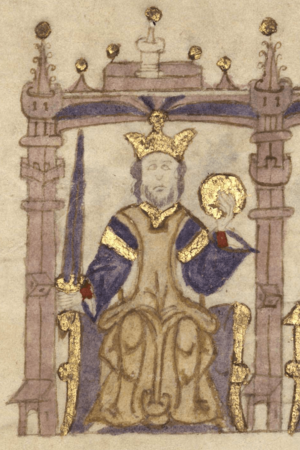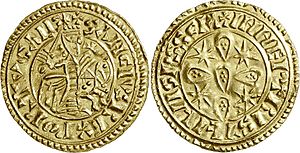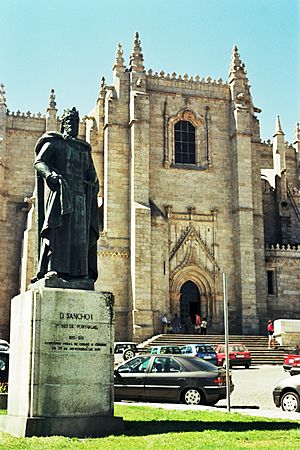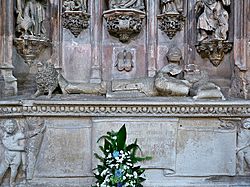Sancho I of Portugal facts for kids
Quick facts for kids Sancho I of Portugal |
|
|---|---|

King Sancho in the Castilian manuscript Compendium of Chronicles of Kings (...) (c. 1312-1325)
|
|
| King of Portugal | |
| Reign | 6 December 1185 – 26 March 1211 |
| Coronation | 9 December 1185 |
| Predecessor | Afonso I |
| Successor | Afonso II |
| Born | Martinho 11 November 1154 Coimbra, Kingdom of Portugal |
| Died | 26 March 1211 (aged 56) Coimbra, Kingdom of Portugal |
| Burial | Santa Cruz Monastery, Coimbra |
| Spouse | |
| Issue Among others... |
|
| House | Portuguese House of Burgundy |
| Father | Afonso I of Portugal |
| Mother | Matilda of Savoy |
| Religion | Roman Catholic |
Sancho I of Portugal (Portuguese pronunciation: [ˈsɐ̃ʃu]) was the second King of Portugal. He was born in Coimbra on November 11, 1154. His nickname was "the Populator" (Portuguese: "o Povoador"). This was because he helped create many new towns.
Sancho was the only surviving son of Afonso I of Portugal, the first king. His mother was Matilda of Savoy. Sancho became king when he was 31 years old. He was crowned in Coimbra on December 9, 1185. He ruled until his death on March 26, 1211. For a short time, he was also known as the King of Silves.
Contents
Early Life and Alliances
Sancho was given the name Martin (Martinho) when he was born. This was because he was born on Saint Martin of Tours's feast day. On August 15, 1170, his father, King Afonso I, made him a knight. From then on, Sancho helped his father rule the country. He also helped lead the army.
At this time, Portugal had just become an independent country in 1139. But its independence was not yet fully secure. The kings of León and Castile wanted to take Portugal back. The Church was also slow to fully support Portugal's independence.
Because of this, King Afonso I looked for allies. Portugal made a deal with the Crown of Aragon. They agreed to fight against Castile and León together. To make this agreement stronger, Sancho married Dulce in 1174. She was the younger sister of King Alfonso II of Aragon. Aragon was the first kingdom in the Iberian Peninsula to recognize Portugal's independence.
Sancho's Time as King
When Afonso I died in 1185, Sancho I became the second king of Portugal. His main city was Coimbra. Sancho decided to stop the long and often useless wars. These wars were fought against Portugal's neighbors over land near the Galician border.
Instead, he focused on the southern parts of Portugal. In 1189, he got help from soldiers who were on their way to the Third Crusade. With their help, he attacked Alvor and captured Silves. An eyewitness wrote a detailed story about this event.
Silves was a very important city in the South. It was a center for trade and government. About 20,000 people lived there. Sancho ordered the city to be made stronger. He also built a castle there. This castle is still an important historical site in Portugal today. For a while, he called himself "King of Portugal and Silves." However, Silves was lost back to the Moors in 1191.
Sancho I spent much of his rule organizing the new kingdom. He saved up a lot of money for the country. He also supported new businesses and helped merchants. He created several new towns and villages. One example is Guarda, founded in 1199. He also worked hard to get people to move to empty areas in the northern Christian parts of Portugal. This is why he was called "the Populator."
King Sancho was also known for loving books and learning. He wrote several poems. He used the royal money to send Portuguese students to universities in Europe. He passed away in Coimbra when he was 56 years old.
Family Life
Sancho married Dulce of Aragon. She was the daughter of Ramon Berenguer IV, Count of Barcelona and Petronilla, Queen of Aragon. They had eleven children together. Eight of them grew up to be adults.
- Theresa (born 1175/1176, died 1250). She married King Alfonso IX of León. She was later recognized as a saint in 1705.
- Sancha (born 1180, died 1229). She started a monastery near Coimbra. Her sister Theresa arranged for her to be buried at the Monastery of Lorvão. She was also recognized as a saint in 1705.
- Constanza (born 1182, died before 1186 or 1202).
- Afonso (born 1186, died 1223). He became the third king of Portugal after his father.
- Raimundo (born 1187/88, died in infancy).
- Peter (born 1187, died 1258). He married Aurembiaix, who was a countess.
- Ferdinand (born 1188, died 1233). He became a count by marrying Joan, Countess of Flanders.
- Henry (born after 1189, died after 1189, in infancy).
- Mafalda (born 1195/1196, died 1256). She married Henry I of Castile. She was recognized as a saint in 1793.
- Branca (born 1198, died 1240). She was likely Berengaria's twin sister. She became a nun in a convent in Guadalajara.
- Berengaria (born 1198, died 1221). She was likely Branca's twin sister. She married Valdemar II of Denmark in 1214.
Other Children of King Sancho
King Sancho also had children with other women. These children were:
- Martim Sanches (born before 1175). He became a count.
- Urraca Sanches (born before 1175). She married Lourenço Soares.
- Rodrigo Sanches (died 1245). He had a son named Afonso Rodrigues.
- Gil Sanches (died 1236). He was a cleric and a poet. His father left him money in his will.
- Nuno Sanches. He died when he was a child.
- Maior Sanches. She also died at a young age.
- Teresa Sanches. Her father left her money in his will. She married Alfonso Téllez de Meneses.
- Constança Sanches (born 1204, died 1269). Her father also left her money. She owned land in different places.
- Pedro Moniz. He had a daughter named Maria Peres de Cabreira.
See also
 In Spanish: Sancho I de Portugal para niños
In Spanish: Sancho I de Portugal para niños




